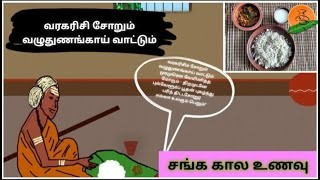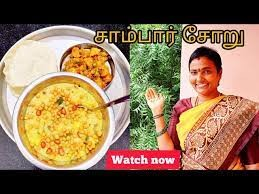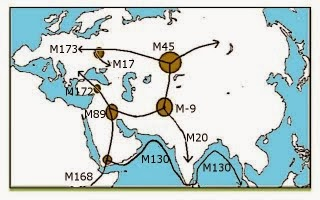"FOOD HABITS OF TAMILS" PART:02 "அறிமுகம் தொடர்கிறது" / "Introduction continuing" [தமிழிலும் ஆங்கிலத்திலும் / In English and Tamil]
இன்று பல நூலாசிரியர்கள் சுமேரியனுக்கும் திராவிடனுக்கும் இடையே உள்ள இனம், மொழி, பண்பாட்டு ஒற்றுமையை [உறவை] அடிப்படையாக கொண்டு இரு இனமும் ஒரே இனக் குழுவை [குடும்பத்தை] சார்ந்ததாக முடிவு செய்துள்ளார்கள். அதாவது ஈலம் [Elam], சுமேரியா மக்கள் திராவிட இனத்தை சேர்ந்தவர்கள் என்பது அவர்களின் முடிவு. டாக்டர் எச்.ஆர். ஹால் (Dr. H.R. Hall) என்ற வரலாற்று அறிஞர் மேசொபோடமியாவிற்கு திராவிடர்கள் இந்தியாவில் இருந்து புலம் பெயர்ந்தார்கள் என்கிறார். அதே நேரம் வேறு அறிஞர்கள் திராவிடர்கள் தமது முன்னைய குடியிருப்பான மத்தியத்தரைக்கடல் பகுதியில் இருந்து இந்தியா புலம் பெயர்ந்தார்கள் என்கிறார்கள். KP பத்மநாபா மேனன் திராவிடர் - சுமேரியர்களின் நெருங்கிய தொடர்புகளைப் பற்றி எழுதியுள்ளார். இவர் ஒரு சிறந்த வழக்கறிஞர், நீதிபதி, வரலாற்றாசிரியரும் ஆவார். பல கீழ்த்திசை மொழிப் புலமையாளர்கள் [Orientalists] சுமேரியர்கள் தொடக்க கால திராவிடர்கள் என்பதை ஒத்துக்கொள்கிறார்கள். அங்கு இருந்து திராவிடர்கள் இந்தியாவின் வட மேற்கு பகுதிக்கு இடம் பெயர்ந்தார்கள். எனினும் அங்கு அவர்கள் பல காலம் வாழ முடியவில்லை. அவர்களை அங்கு வந்த ஆரியன் குழு தாக்கி அவர்களை நிரந்தரமாக தென் இந்தியாவில் தங்க வைத்து விட்டது. இதை, இந்த கருது கோளை, நம்பகமான அறிஞர்கள் வலிமையாக ஆதரித்து வாதாடுகிறார்கள்.
பன்மொழிப் புலவரும் பேராசிரியருமான இலங்கையை சேர்ந்த மறைந்த ஆறுமுகம் சதாசிவம், மலேசியாவை சேர்ந்த முனைவர் கி.லோகநாதன், அறிவியல் பல்கலைக்கழகம், பினாங்கு.போன்றோர் இதில் பல ஆய்வுகள் / முயற்சிகள் செய்துள்ளார்கள். பேராசிரியர் ஆ. சதாசிவம் மற்றும் முனைவர் கி.லோகநாதன் போன்றோர்கள் சுமேரிய மொழியையும், திராவிட மொழியையும், ஒப்பியல் முறையில் ஆராய்ந்து சுமேரிய மொழியையும் திராவிட மொழி என நிறுவினார்கள். இந்திய வரலாற்றாளர்களுள் குறிப்பிடத்தக்கவரான கல்லிடைக்குறிச்சி அய்யா நீலகண்ட சாத்திரி அவர்கள் கோயில் வழிபாட்டில் உள்ள ஒத்த தன்மையை சுட்டிக்காட்டியுள்ளார். திராவிடர்களின் மூதாதையர்களை மத்தியத் தரைக்கடல் பகுதியுடன் இணைக்கும் இந்த கருது கோளை, நம்பகமான அறிஞர்கள் இன்னும் ஆதரித்து வாதாடுகிறார்கள். எனவேதான் சுமேரியா மற்றும் சிந்துவெளி நாகரிக வரலாறுக்கூடாக தமிழரின் உணவு பழக்கங்களின் வரலாற்றை நான் இங்கு அலச உள்ளேன்.
தமிழர்களின் நாளாந்த உணவு மிக எளிமையானது. அது அதிகமாக வேகவைத்த அரிசி [சோறு], சாம்பார் [தமிழ் நாடு] அல்லது வேகவைத்த அரிசி [சோறு], சொதி, மரக் கறி [இலங்கைத் தமிழர்] ஆகியவற்றுடன், மீன் அல்லது இறைச்சி [அசைவ உணவாளர்களுக்கு], ரசம், தயிர் போன்றவற்றை கொண்டுள்ளது. சிறப்பு சந்தர்ப்பங்களில் - அரிசி, பால், சவ்வரிசி, சேமியா, சக்கரை, ஏலக் காய், முந்திரிப்பருப்பு முதலிய வற்றைக் கொண்டு செய்யப்படும் பாயாசம் பரிமாறப் படுகிறது. இன்றைய நவீன கால தமிழ் சமையல் வகையில் காபி [குழம்பி], தேநீர் போன்றவை முதன்மை குடிப் பழக்கமாக மாறியுள்ளது. இது பெரும் பாலும் காலை உணவுடனும் சிலவேளை இரவு உணவுடனும் குடிக்கப்படுகிறது. வளமான, செல்வம் மிக்க குடும்பத்தில் கூட நாளாந்த சாப்பாட்டில் பெரும் வேறுபாடு காணமுடியாது. ஆனால், விருந்தினர்கள் அவர்கள் வீட்டில் வரும் பொழுது அல்லது திருமண வைபவம் நடை பெரும்பொழுது முற்றிலும் வேறு பாடாக, அங்கு இன்சுவை சாப்பாடு பரிமாறப்படும். அது மட்டும் அல்ல, அங்கு பரிமாறப்படும் உணவு அவர்களின் செல்வ நிலையை காட்டுவதாகவும் இருக்கும். இன்று நகர்ப் புறங்களில் துருப் பிடிக்காத உருக்கினால் செய்யப்பட்ட கரண்டி, முள்கரண்டி, உணவு கலன்கள் போன்றவை பாவிக்கப்பட்டாலும் ஒரு விழா, சடங்கு என்பனை நடை பெரும் பொழுது, பாரம்பரிய முறைப்படி அனை வருக்கும் தலை வாழை இலையில் அறுசுவை உணவு பரிமாறப் படுகிறது. இங்கு விருந்தினருக்கு முன்னால் இலையின் நுனி - பொதுவாக வலது கை பாவிப்பவர்கள் பெரும்பாலும் இருப்பதால் - இடது பக்கம் இருக்கக் கூடியதாக வைக்கப்படுகிறது. வாழை இலையில் உணவு பரிமாறல் 3000 ஆண்டு பழமை வாய்ந்ததாகவும், ஆகக் குறைந்தது கட்டாயம் 1500 ஆண்டுகளுக்கு முன்பே பரவலாக தமிழர் வாழ் விடங்களில் பாவிக்கப் பட்டதாகவும் இருக்கலாம் எனவும் அறியப்படுகிறது. ஆகவே இது - வாழையிலையில் பரிமாறல் - ஒரு வரலாற்று ரீதியான காரணத்தையும் கொண்டுள்ளது. வாழை இலையை, அது பெரிய பரப்பளவை கொண்டதாக இருப்பதால், அதில் உணவு பரிமாறல் இலகுவாக இருந்ததாலும், மேலும் தண்ணீரை அதன் மேல் தூவுவது அல்லது தெளிப்பது மூலமே இலகுவாக கழுவக் கூடியதாக இருந்ததாலும், அதனால் சுகாதார மானதாக அமைந்ததாலும், அதே நேரம் இது நீர் உறியாதன்மையை கொண்டிருப்பதாலும் மற்றும் சில நன்மை பயக்கும் காரணங்களாலும் எமது முதாதையர்கள் இதை தெரிந்து எடுத்து இருக்கலாம். திராவிடர்களின் உணவு பொதுவாக பல நீர் வகைகளை கொண்டவை, மற்றும் அகன்ற இடமும் தேவைப்படுகிறது. ஆகவே தாமரை இலையை அல்லது வேறு இலைகளை விட இது மிகவும் பொருத்தமாக அன்று இருந்து இருக்கும். மேலும் இவ் வாழை இலையில் சூடான உணவுகளை பரிமாறும் போது, அது நல்ல நறுமணத்தை கொடுத்து ரசம் போன்ற சில உணவுகளின் சுவையையும் கூட்டுகிறது. முன்னைய, பண்டைய நாட்களில், வீட்டின், சமையல் அறையின் தரைகள் களி மண்ணால் அல்லது சாணத்தால் அல்லது இரண்டாலும் மெழுகப்பட்டதாக இருந்தன. ஆகவே எறும்புகள் இலகுவாக சாப்பாட்டு இலைக்கு ஊர்ந்து வரக்கூடியதாக இருந்தன. எனவே அவையை தடுக்கும் பொருட்டு அன்றைய நாட்களில் இலையை சுற்றி, சாப்பிட தொடங்கும் முன்பு நீர் தூவப்பட்டன என்பதும் குறிப்பிடத்தக்கது.
தமிழரின் 2000 ஆண்டுகளுக்கு முந்தைய காலத்தைப் பற்றி நாம் சற்று சிந்தித்தால், இளங்கோ அடிகள் அல்லது தொல்காப்பியர் போன்றவர்கள் எம் கண்முன் வருவார்கள். அவர்கள் என்ன சாப்பிட்டார்கள் என்று எப்போதாவது நாம் யோசித்தோமா? கட்டாயம் நாங்கள் அந்தக் காலத்தின் சமையலறைகளை இனி எட்டிப்பார்க்க முடியாது. ஆனால், பரந்துபட்ட சங்க இலக்கியத்தின் பக்கங்கள் பழங்காலத் தமிழர் உணவு எப்படி இருந்தது என்பதை உங்களுக்கு விபரமாகச் சொல்லும். புகழ்பெற்ற கவிஞர் அவ்வையார், ஒரு சூடான வெயில் நாளில் ஒரு இதயமான மதிய உணவை அழகாக விவரிக்கிறார். அவரது 'தனி பாடல் திரட்டு' -- கவிதைத் தொகுப்பில் - 32வது பாடல் இப்படி செல்கிறது:
"வரகரிசி சோறும் வழுதுணங்காய் வாட்டும்
முரமுரவெனவே புளித்த மோரும் திரமுடனே
புல்வேளூர்ப் பூதன் புரிந்து விருந்து
இட்டசோறு எல்லா உலகும் பெறும்"
வரகரிசி சோறு, வழுதுணங்காய் பொரியல் (கத்திரிக்காய் பொரியல்) புளித்த மோர் - அவ்வளவு தான். இந்த சுவையில் மயங்கிய நம் ஔவை பாட்டி 'இதற்கு உலகையே ஈடாகத் தரலாம்' என்றதுடன் தனக்கு விருந்தளித்தோன் பெயரை புல்வேளூர் கிராமத்தின் பூதன் என்று குறிப்பிட்டு, சுவையான உணவுக்கு நன்றியும் தெரிவிக்கிறார்.
நன்றி
[கந்தையா தில்லைவிநாயகலிங்கம்,
அத்தியடி, யாழ்ப்பாணம்]
பகுதி :03 'அறிமுகம் தொடர்கிறது' தொடரும்
Theebam.com: "தமிழரின் உணவு பழக்கங்கள்" பகுதி: 03:
Theebam.com: "தமிழரின் உணவு பழக்கங்கள்"பகுதி: 01:
"FOOD HABITS OF TAMILS" / PART 02 'Introduction continuing'
Many Authors have pointed out ethnic, linguistic and cultural affinities between the Sumerians (Mesopotamians) and the Dravidians of South India, and concluded that both probably belonged to the same ethnic stock. That is the ancient Sumerian civilizations of Mesopotamia and of Elam (southern Iran) were associated with Dravidians .HR Hall is of the opinion that Dravidian people must have migrated to Mesopotamia from India, whereas others think Dravidians came from Mediterranean regions, which was their earlier home. KP Padmanabha Menon writes about their close relationship.Padmanabha Menon was an eminent Advocate, Judge and Historian. He also wrote Kochi Rajya Charithram (History of Cochin).Orientalists, many of them, are prepared to concede that the Sumerians, the Mediterranean race, are branches of the early Dravidians. From SUMER, Dravidians started moving through North west corner of India to reach Indus valley where they were not to remain long. They were attacked by Indo Aryan tribes and driven south, where they remain ever since.
Also, Multilingual scholar and professor Late Arumugam Sathasivam from Sri Lanka, Dr. K. Lokanathan from Malaysia, University of Science, Penang etc. have done many studies / efforts in this. Professor B. Satasivam and Dr. K. Lokanathan etc. studied Sumerian language and Dravidian language comparatively and established Sumerian language as Dravidian language. Aya Neelakanda Chatri, a noted Indian historian of Kallidaikurichi, has pointed out the similarity in temple worship. This hypothesis, which links the ancestors of the Dravidians to the Mediterranean region, is still supported and argued by reliable scholars.Therefore I analysis this article of "FOOD HABITS OF TAMILS" through Sumerian & Harappa-Mohenjo daro.
The everyday diet of Tamil people is fairly austere, consisting of
boiled rice, sambar (dhal [lentils] vegetable and tamarind) or Sothi with
vegetable curries [sri lankan Tamils], fish or meat curry (for
non-vegetarians), rasam (spicy pepper water) and curds. On special occasions
payasam, a milk-based dessert flavoured with cardamom, is served. In modern Tamil
cuisine coffee and Tea has become one of the main drinks. It is always drunk at
breakfast, occasionally at dinner. Even in affluent Tamil families there is not
much variety in the daily menu, but when there are guests or a wedding is held
it is a totally different story, and a truly ambrosial meal will be served. The
food served on these occasions is generally an indication of the hosts' status.
Though stainless steel cutlery and crockery are used in urban homes, food is
still served on ceremonial occasions in the traditional way- on a banana leaf.
The leaf is spread in front of the diner, with the tip pointed left as most of
the people used their right hand to eat food. The usage of banana leaf to serve
food dates back to at least 1500 years and could be as old as 3000 years. So
there is definitely historical reasons for it. But the choice of banana leaf
during those times could be because (just hypothesizing] It is bigger and
convenient to serve food. Available easily
in those days. It is hygienic. A simple
sprinkling of water is enough to clean a banana
leaf. It is waterproof. Dravidian foods involve a lot of liquids and
many other bio materials don't fit in easily. It adds a nice aroma to the hot
food and improves the taste of some foods like rasam. Earlier days, flooring
were of mud or cow dung covered. Hence, It was easier to ants to crawl into the
leaf during meals. So, water is ring around the leaf in those days .
Ever wondered what the likes of Ilango Adigal or Tholkappiyar ate?
Well, we are talking about a period that's 2000 years ago and it's impossible
to peek into the kitchens of those times. But the pages of the vast Sangam
literature may take you back in time to understand what ancient Tamil food was
like.
The celebrated poet Avvaiyar goes on to describe a hearty lunch on a
hot sunny day. In her ' Thani padal thirattu' -- an anthology of poems – the
32nd song goes like this -- ' Varagu arisi chorum, vazhuthunangai vaatum,
moramoravena pulitha morum... ' (steamed varagu rice, smoked and mashed
aubergine and tangy frothy buttermilk). The poet mentions her host's name as
Boothan of Pulvelur village and expresses gratitude for the tasty meal.
Thanks
[Kandiah Thillaivinayagalingam,
Athiady, Jaffna]
PART :03 'Introduction continuing' WILL FOLLOW

















0 comments:
Post a Comment